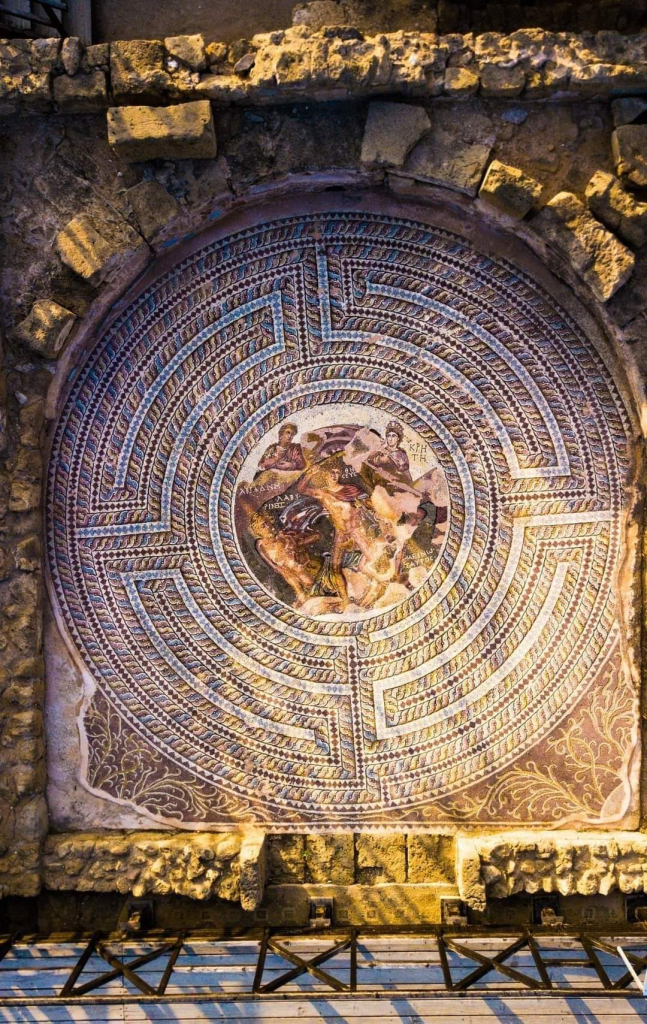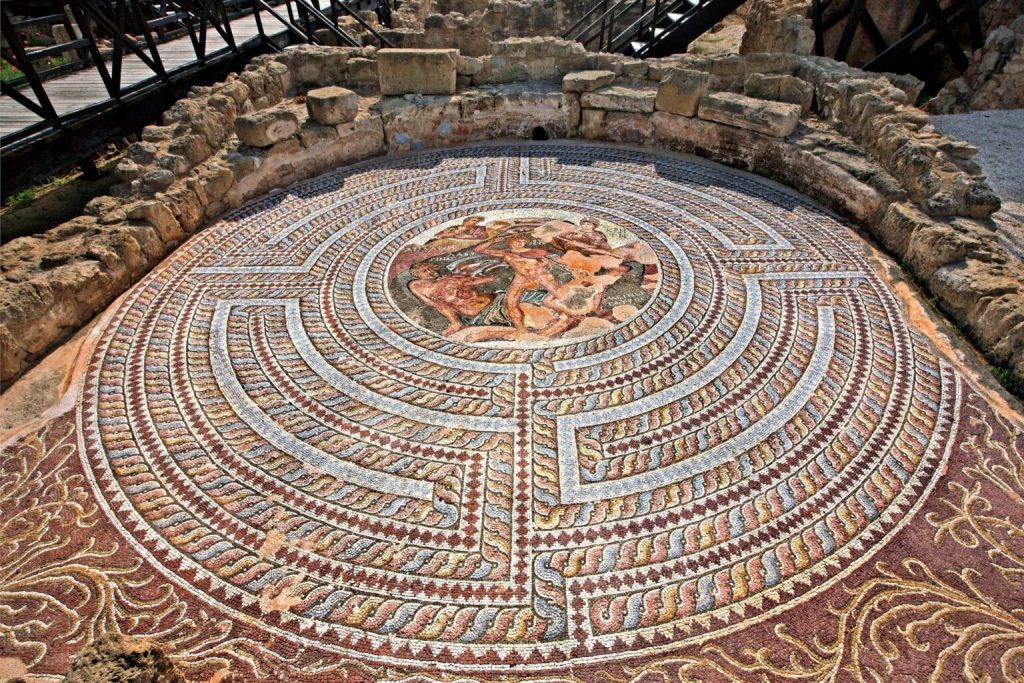For over a decade, the “Acropolis of Paphos” has captured the attention of archaeologists, becoming a focal point of intense study and excavation. Nestled in the picturesque landscape of Kato Paphos, Cyprus, Fabrika Hill has gradually revealed its secrets thanks to the unwavering efforts of researchers from the University of Avignon in France. With over 12 years of dedication, these experts have unearthed remarkable findings, shedding light on the rich historical and cultural tapestry of the region. Their persistence has culminated in a recent discovery of extraordinary significance, offering fresh insights into the ancient world and captivating scholars and history enthusiasts alike.
Unveiling the Beauty of Hellenistic Artistry
In the latest phase of their excavations, the archaeological team uncovered an exceptional mosaic floor dating back to the Hellenistic period. This discovery, both breathtaking and historically significant, was part of a larger chamber, suggesting the grandeur and sophistication of the structures that once adorned this prominent hill. The mosaic, with its intricate designs and masterful artistry, serves as a testament to the skill and creativity of ancient craftsmen. Every tile, meticulously placed, tells a story of a bygone era where art and architecture flourished in harmony with the cultural and social dynamics of the time.

The team’s discovery offers more than just an aesthetic marvel; it provides a rare glimpse into the daily lives and values of the people who inhabited the area centuries ago. The patterns and symbols embedded within the mosaic may hold clues about the religious, social, or economic practices of the period. For researchers, this find is a window into the Hellenistic age, a pivotal era that influenced the course of Western civilization.
Ancient Engineering: A Marvel of Technological Sophistication
Adding to the intrigue of the site, the team uncovered an advanced clay pipe system that once supplied water to the building housing the mosaic. This plumbing network, remarkably well-preserved despite the passage of centuries, is a testament to the engineering ingenuity of ancient civilizations. Professor Claire Balandier, who leads the University of Avignon’s Archaeological Mission, presented the findings to the Paphos Municipal Council, highlighting the significance of this ancient infrastructure.
The clay pipes, still in “very good condition,” demonstrate the sophistication of Hellenistic engineering. They offer valuable insights into how water was transported and managed, showcasing a level of technological prowess that rivals modern systems. This discovery not only underscores the practical ingenuity of the period but also provides a deeper understanding of how communities addressed essential needs such as water distribution. The preservation of such systems over millennia is a marvel in itself, inspiring awe and respect for the engineers of antiquity.
Layers of History: A Tale of Construction and Transformation
Excavations on Fabrika Hill have unearthed a complex narrative of construction, destruction, and adaptation over centuries. The Hellenistic-era building, characterized by its impressive craftsmanship and architectural elegance, faced significant changes during the Roman period. New water infrastructure installed by the Romans partially destroyed the older structure, yet these modifications added new dimensions to the site’s historical significance.
This layered history reflects the evolving priorities and technologies of successive civilizations. The juxtaposition of Hellenistic and Roman elements within the same site provides a unique opportunity to study the interactions and transitions between two influential cultures. While the Romans’ practical innovations altered the original structure, they also contributed to the rich historical tapestry of Fabrika Hill, offering a multidimensional perspective on the site’s development.
Collaboration Across Borders: A Global Effort in Archaeology
The work on Fabrika Hill is part of a broader archaeological initiative in the Paphos region, highlighting the power of international collaboration. Teams from the University of Krakow, led by Professor Evdoxy-Papoutsi-Wladyka, and Sydney University, under the direction of Dr. Craig Barker, have joined forces with the University of Avignon to explore and document this historically rich area. Each team brings unique expertise and perspectives, contributing to a comprehensive understanding of Paphos’s ancient heritage.
Among the notable discoveries is an impressive 8,000-seat Hellenistic theater unearthed by the Sydney University team. This grand structure, once a hub of cultural and social activity, underscores Paphos’s significance as a major center of the ancient world. The theater’s scale and architectural sophistication reflect the city’s prominence and its role in fostering artistic and communal expression. Together, these discoveries illuminate the interconnectedness of various aspects of life in ancient Paphos, from public entertainment to private dwellings and infrastructure.
A Window into the Past: Cultural and Historical Significance
Fabrika Hill serves as a microcosm of the broader historical and cultural developments that shaped the ancient Mediterranean. The findings at the site provide a wealth of information about the daily lives, artistic achievements, and technological advancements of the Hellenistic and Roman periods. For historians and archaeologists, each artifact and structure unearthed is a piece of the puzzle, contributing to a fuller picture of the past.

The mosaic floor, in particular, has captured the imagination of scholars and visitors alike. Its intricate designs and vivid colors evoke a sense of wonder, transporting observers to a time when artistry and craftsmanship were held in the highest regard. For the people who created and walked upon this mosaic, it was likely a source of pride and a reflection of their cultural identity. Today, it stands as a bridge between the ancient and modern worlds, reminding us of the enduring legacy of human creativity.
The Road Ahead: Promising Future Discoveries
As excavations continue, Fabrika Hill remains a beacon of historical curiosity and promise. The site’s rich layers of history, from the Hellenistic period to Roman modifications and beyond, offer endless opportunities for exploration and discovery. Researchers are optimistic that future digs will uncover even more spectacular finds, deepening our understanding of the ancient world and its enduring impact on contemporary society.
For the University of Avignon team, the journey has been one of perseverance and passion. Over the years, their efforts have not only advanced the field of archaeology but also fostered greater appreciation for the cultural heritage of Cyprus. Each discovery, no matter how small, adds to the narrative of Fabrika Hill, transforming it into a living testament to the ingenuity and resilience of ancient civilizations.
A Legacy for Generations to Come
The ongoing work at Fabrika Hill is more than an academic endeavor; it is a celebration of our shared human heritage. The findings from the site have the potential to inspire future generations, sparking curiosity and a deeper appreciation for the achievements of our ancestors. Through the collaboration of international teams and the support of local institutions, the legacy of Fabrika Hill is being preserved and shared with the world.

In the years to come, Paphos’s ancient treasures will continue to captivate and educate, offering valuable lessons about the ingenuity, artistry, and resilience of the people who came before us. Fabrika Hill stands as a testament to the enduring allure of the past, a source of inspiration and wonder for all who seek to understand the complexities of human history.





